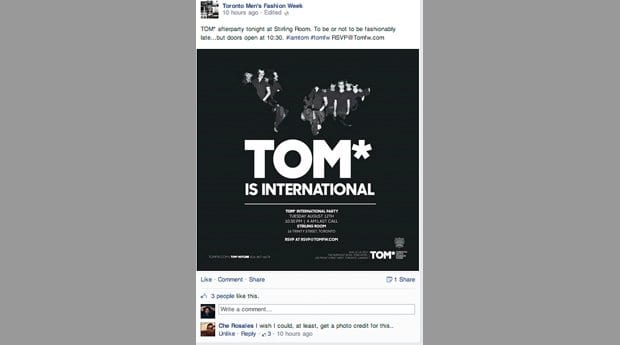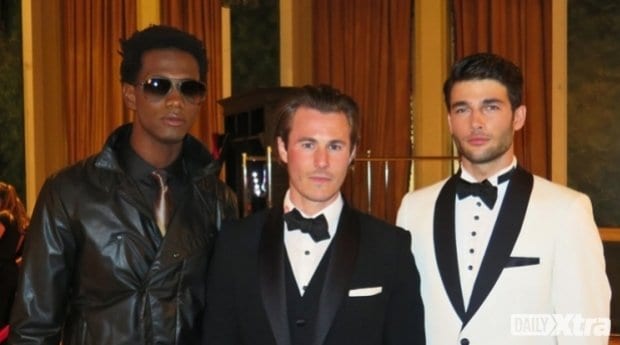
Photographer Che Rosales lamented on Facebook that he wasn’t credited for the use of his photograph for a “TOM* is International” poster. Credit: Facebook.com
Toronto Men’s Fashion Week (TOM) debuted Aug 12 under clouds of controversy. Pay attention, fashionistas: here’s the backstory!
Days before the event began, a number of photographers (including JR Bernstein) walked after being asked to sign restrictive waivers. Photographer Che Rosales lamented on Facebook that he wasn’t credited for the use of his photograph for a “TOM* is International” poster; see photo gallery above. Next, avant-garde designer Mic Carter and his L’uomo Strano collection were unceremoniously dropped from the lineup: Carter’s team says executive director Jeff Rustia and producer/promoter Hans Koechling blamed it on his work being “too feminine,” “not masculine enough” and “emasculating,” while Rustia told the Toronto Star that the “workmanship needs to be improved. He needs to work harder on his collection.”
This led to accusations of homophobia, misogyny and femme-phobia and the kind of social-media shit-storm that nightmares are made of. Quietly, TOM reversed its decision and allowed Carter to show his collection . . . but not before a huge amount of sturm und drang that left many with bad tastes in their mouths.
Now, there are always three sides to every story: your version, the other person’s and the truth. I love getting to the bottom of things, so I asked around, paid attention to social media, and reached out to everyone involved. Everyone was forthcoming, except for one person (more on him later), and most of the stories seem to paint the same picture.
First, let’s look at the restrictions the shutterbugs faced before choosing to walk away. They had to do with ownership of intellectual property, right-to-sue and that old bugaboo: compensation. An experienced photographer who requested anonymity told me, “You should have seen the photo waiver they presented to anyone doing images. Essentially, they want to own every frame, to which I replied, ‘There isn’t enough “portfolio opportunity” in the world to warrant stripping my rights as a creator.’” Allegedly, the waivers in question guaranteed TOM complete and total control and ownership over every bit of material . . . without having to pay for it.
When it comes to Carter, his detailed and skillfully constructed work has been much talked about, both here in Xtra and in other media outlets. His concepts and attention to detail are second to none; TOM organizers agree or they wouldn’t have showcased pieces from the line in their magazine or their social-media feed prior to the event. If there were quality issues, why wasn’t it a problem earlier?
“They sought me out, and it was sold to me as an opportunity to participate in a world-class fashion event,” Carter says. “The collection was done. Saturday’s fitting went really well, and then I got a call where I was asked/told to have a stylist come in and make the collection extremely more masculine. On Monday, I received a call from the stylist saying, ‘Your show’s been cancelled.’”
Again, if the issue was quality, why wouldn’t the call come from Rustia or another higher-up? Carter is insistent that the issue wasn’t at any point presented to him as being workmanship-based. “We just hosted WorldPride! We’re supposed to be leaders of the charge in gender and queer issues. I’m very transparent about the brand’s attachment to these issues, these expansive conceptions of gender.”
When the couture hit the fan, fashion writer Kevin Naulls sent no fewer than 60 emails, trying to get someone, anyone, from TOM to comment before he broke the news. “What I can’t understand is making observations of whether a collection is complete or passable only two days before the show. That seems like something that should have taken place two weeks ago? A month ago? Whatever constitutes a decent amount of time for a designer to make required edits,” he says. “If you ask for an artist’s vision, you take it. If Carter were burning crucifixes or preparing to throw dog shit at the front row, I’d believe there’d be reason to request some changes, but even then, it’s a fine line for censorship; a worry that a collection for a men’s fashion week is ‘too feminine’ is archaic and has no place in fashion.”
But what if, for some bizarre reason, Carter’s work wasn’t up to snuff this time around? Does that change the course of action Rustia took? “I don’t think he should have ragged on a designer in the Toronto Star. It is one thing to deny allegations; it’s another thing to disrespect an artist’s work for the sake of clarity. As the executive director of a fashion week, it surprises me that he took this approach at all,” Naulls says.
With TOM, all roads lead back to Rustia. Because we are friendly (certainly as friendly as I am with Carter, Naulls and the anonymous-by-request photographer), I reached out to him via Facebook, Twitter and email. I have enormous respect for his achievements, openly admire his style and thought he’d be eager to refute these claims and defend the hard work he put in on the event. Surprisingly, no response. He did, however, tell the Toronto Star, “I’m a big supporter of the LGBTTIQQ2SA community.”
If that is true, why did he stonewall gay media? He deserves credit for reversing his decision to drop Carter, but it’s increasingly clear Carter shouldn’t have been dropped in the first place. With growing pains like these, it’s no wonder some people are wondering if TOM will happen again next year.
Read Ryan G Hinds’s Toronto at Night column every two weeks on dailyxtra.com.

 Why you can trust Xtra
Why you can trust Xtra


